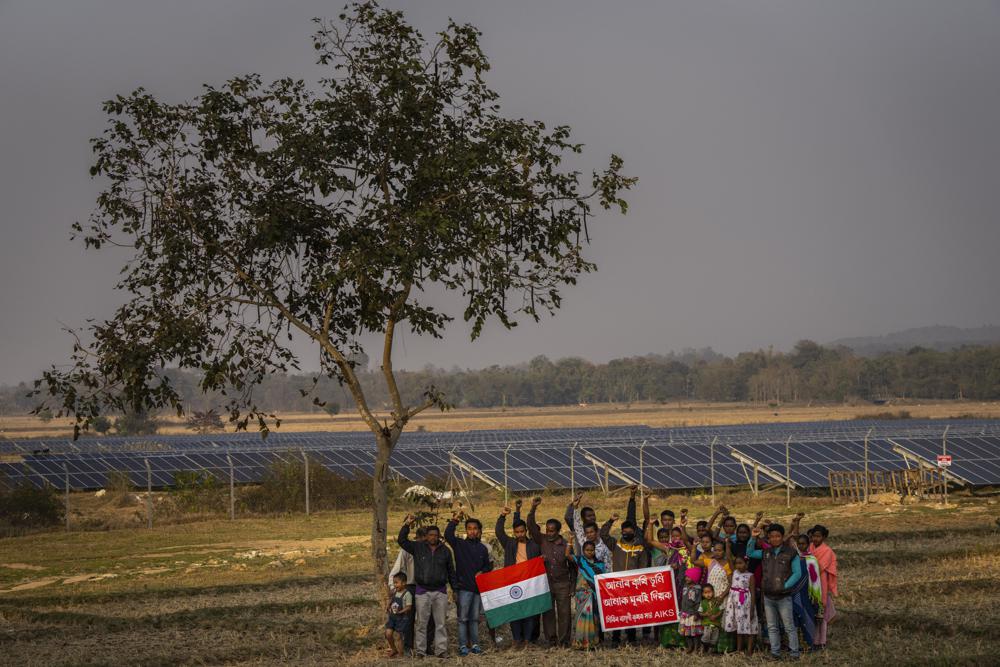

Plans to build a sprawling solar park on land cultivated for generations by indigenous farmers in India’s Himalayan foothills erupted in violent clashes with police last year after their crops were bulldozed for the development.
The lush green village in Nagaon district — still largely unconnected to the grid and home to families who earn less than $2 a day — is now framed by blue solar panels, barbed wire, and armed guards. The solar developer Azure Power, listed on the New York Stock Exchange, said in an email that the company legally bought 91 acres (38 hectares) in the village from “recorded landowners” and it’s “incorrect and erroneous” to say the land was forcibly taken.
However it plays out in a district court, the dispute not only speaks to India’s often-tangled land ownership rules rooted in its colonial era It also illustrates the complexity and immensity of the challenges facing the country of nearly 1.4 billion people in meeting its renewable power goals for the next decade.
Over the next 20 years, India’s demand for electricity will grow more than anywhere else in the world. Unlike most countries, India still has to develop and lift millions from poverty, and it will also need to build a power system the size of the European Union’s.
How India meets its energy and economic needs will have an outsized impact on the world’s climate goals. The country is a major contributor of greenhouse gasses from the burning of coal and other fossil fuels.
Prime Minister Narendra Modi said at last year’s United Nation climate talks that India would increase its capacity of non-fossil fuels electricity to 500 gigawatts by 2030 — from the 104 gigawatts at the start of this year. To meet its goals, India must add four times the amount of power the average nuclear plant produces — every month until 2030.
For India, it’ll be a “gargantuan task,” requiring investments between $20 billion and $26.8 billion, while only $10 billion is available, a parliamentary committee said last month.
Some obstacles to renewables — such as the need to build electricity storage for when the sun isn’t shining or wind isn’t blowing — are global challenges. Others are more specific to India — such as the question of who owns land in poor communities that bear the least responsibility for the climate crisis and the need to realign power systems that have relied on coal for centuries. But big solar and wind facilities are sparking conflicts with local communities. This is partly because land ownership is fuzzy at many project sites. For example, some communities have used the land for centuries to farm or graze cattle without legal rights over it. As governments and companies focused on transitioning away from fossil fuels, such conflicts were “collaterals” that had to be managed, Kanchi Kohli, an environmental researcher at the Indian think tank Center for Policy Research.
Mandatory environmental impact assessments were waived for solar and wind projects to make them more viable. But environmental issues still have arisen. For instance, India’s Supreme Court in April 2021 ordered that transmission lines for solar energy be put underground after environmentalists reported the lines were killing critically endangered great Indian bustards. Nine months later, the federal government said burying the lines to safeguard the birds would be too costly and would impede green energy development. The court is hearing the matter again.
With a coastline of over 4,670 miles (about 7,500 kilometers), India could potentially build enough offshore wind farms to provide roughly a third of the country’s 2021 electricity capacity by 2050, according to an assessment led by the Global Wind Energy Council. But these are very expensive to build — and the first such project, a wind farm proposed for the Arabian Sea in 2018, has yet to get underway.